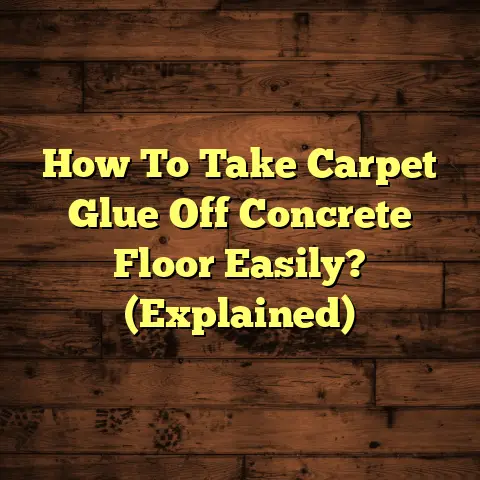Wet Laminate Ruined? (3-Step Rescue Plan!)
Picture this: You walk into your living room, ready to relax after a long day, and squish.
Your heart sinks.
A pipe burst, the kids left the tub overflowing, or maybe it was just a rogue bucket – whatever the cause, your beautiful laminate flooring is soaked.
Panic sets in.
“Is it ruined?
How much is this going to cost me?”
I’ve been there, seen it all, as a flooring contractor for over 15 years.
I know that feeling of dread.
But don’t despair just yet!
Laminate can be surprisingly resilient, and with the right approach, you might just be able to save it.
This article is your 3-step rescue plan.
I’ll walk you through understanding the problem, drying everything out, and deciding whether to repair or replace.
Plus, I’ll share my pro tips for preventing this from happening again.
Let’s get started!
Section 1: Understanding the Problem
The Nature of Laminate Flooring
So, what exactly is laminate flooring?
It’s not solid wood, that’s for sure.
Think of it like a multi-layered sandwich.
- Wear Layer: The top layer, a clear, protective coating that resists scratches and stains.
- Decorative Layer: This is the pretty part – a high-resolution image of wood, stone, or tile.
- Core Board: Usually made of high-density fiberboard (HDF) or medium-density fiberboard (MDF).
This is the main structural component. - Backing Layer: A moisture-resistant layer that provides stability and helps prevent warping.
Laminate’s popularity stems from its affordability, realistic appearance, and relatively easy installation.
According to Statista, laminate flooring accounts for a significant portion of the flooring market, with sales reaching billions of dollars annually.
It’s a budget-friendly way to get the look of hardwood without the hardwood price tag.
Identifying Water Damage
Okay, so you’ve got a wet floor.
But how bad is it really?
Here’s what to look for:
- Warping: Are the planks starting to lift or bubble?
This is a sign the core board is absorbing water and expanding. - Buckling: This is more severe warping, where the planks are actually pushing against each other and lifting up in the middle.
- Discoloration: Water stains can appear as dark spots or streaks on the surface of the laminate.
- Peeling: The decorative layer might start to peel away from the core board, especially at the seams.
- Swelling: Planks get thicker, especially at the edges.
Visual Guide:
(Imagine here a photo showing examples of warping, buckling, discoloration, and peeling on laminate flooring.
Since I can’t insert images, try searching online for “laminate flooring water damage examples” to get a clear picture.)
To really assess the damage, get down on your hands and knees and inspect the seams between the planks.
Are they tight and flush, or are they starting to separate?
The Risks of Inaction
Ignoring water damage in laminate flooring is like ignoring a toothache – it only gets worse.
Here’s why you need to act fast:
- Mold Growth: Damp, dark environments are breeding grounds for mold.
Mold can damage your flooring, cause health problems, and spread to other areas of your home.
According to the EPA, mold can cause allergic reactions, asthma attacks, and other respiratory issues. - Further Deterioration: The longer the laminate stays wet, the more the core board will absorb water, leading to more warping, buckling, and eventually, complete structural failure.
- Subfloor Damage: Water can seep through the laminate and damage the subfloor underneath, leading to even more costly repairs.
- Unpleasant Odors: Mold and mildew can create a musty, unpleasant odor that’s difficult to get rid of.
Don’t let a small problem turn into a major headache.
Time is of the essence!
Section 2: The 3-Step Rescue Plan
Alright, let’s get to the good stuff.
Here’s my tried-and-true 3-step rescue plan for wet laminate flooring.
Step 1: Assess the Damage
Before you start tearing things up, you need to figure out the extent of the problem.
A thorough assessment will help you decide whether you can salvage the floor or if replacement is the only option.
- Visual Inspection: Start with a close visual inspection, as described above.
Document the damage with photos or videos.
This will be helpful for insurance claims or when consulting with a professional. - Moisture Meter: Invest in a moisture meter (you can find them at most hardware stores).
This tool measures the moisture content of the laminate and subfloor.
Aim for a reading below 12% for wood subfloors and below 5% for concrete.
High readings indicate that the floor is still wet and needs more drying time. - Check the Underlayment: The underlayment is the thin layer of foam or felt that sits between the laminate and the subfloor.
It can trap moisture and contribute to mold growth.
Lift a few planks (carefully!) to inspect the underlayment.
If it’s wet or moldy, it needs to be replaced. - Sniff Test: Trust your nose!
A musty odor is a telltale sign of mold growth.
Differentiating Damage:
- Minor Damage: Slight warping around the edges, minimal discoloration, moisture meter readings within acceptable ranges.
- Severe Damage: Significant buckling, widespread discoloration, peeling, high moisture meter readings, mold growth, damaged underlayment.
If you’re dealing with minor damage, you have a good chance of saving your floor.
Severe damage, unfortunately, usually means replacement.
Step 2: Drying Out the Area
This is the most crucial step.
The faster you dry out the laminate, the better your chances of preventing permanent damage.
- Remove Standing Water: Use towels, mops, or even a wet/dry vacuum to remove any standing water.
The faster you get rid of the excess water, the better. - Increase Ventilation: Open windows and doors to create airflow. This will help evaporate moisture.
- Fans: Place fans strategically around the affected area to circulate air.
Aim the fans at the floor, but don’t place them too close, as this can create uneven drying. - Dehumidifiers: Dehumidifiers are your best friend in this situation.
They remove moisture from the air, speeding up the drying process.
Run the dehumidifier continuously until the moisture meter readings are within acceptable ranges. - Remove Baseboards (Optional): If you suspect water has seeped behind the baseboards, carefully remove them to allow for better airflow.
This will also give you a chance to inspect for mold. - Lift Planks (If Necessary): If you suspect significant moisture trapped underneath the laminate, you may need to carefully lift a few planks to allow for better drying.
Use a pry bar and be gentle to avoid damaging the planks.
Ideal Drying Time and Conditions:
Drying time depends on the severity of the water damage and the environmental conditions.
Generally, it can take anywhere from a few days to a few weeks.
- Temperature: Aim for a temperature between 60-80°F (15-27°C).
- Humidity: Keep the humidity level below 50%.
- Airflow: Ensure good airflow throughout the room.
Monitor the moisture meter readings regularly to track your progress.
Be patient and don’t rush the drying process.
Step 3: Repairing or Replacing the Laminate
Okay, the floor is dry.
Now what?
It’s time to decide whether to repair or replace.
Repairing Damaged Laminate:
This is an option if you have minor damage, such as slight warping or discoloration.
- Replacing Individual Planks: If only a few planks are damaged, you can replace them.
- Tools You’ll Need: Utility knife, pry bar, tapping block, hammer, adhesive (if needed), replacement planks.
- Step-by-Step Guide:
- Carefully score the damaged plank with a utility knife along the seams.
- Use a pry bar to gently lift the plank.
- Clean the subfloor.
- Apply adhesive (if needed) to the back of the new plank.
- Position the new plank and tap it into place using a tapping block and hammer.
- Fixing Minor Warping:
- Weighting: Place heavy objects (books, weights) on the warped area for several days to flatten it.
- Heat (Use with Caution!): Use a hairdryer on a low setting to gently heat the warped area.
This can help soften the laminate and make it easier to flatten.
Be careful not to overheat the laminate, as this can cause further damage.
Replacing the Entire Floor:
This is necessary if you have severe damage, such as significant buckling, widespread discoloration, or mold growth.
- Tools You’ll Need: Pry bar, utility knife, tapping block, hammer, moisture meter, safety glasses, dust mask, new laminate flooring, underlayment, spacers.
- Step-by-Step Guide:
- Remove the baseboards.
- Use a pry bar to remove the old laminate flooring.
- Inspect the subfloor for damage and make any necessary repairs.
- Install a new underlayment.
- Install the new laminate flooring according to the manufacturer’s instructions.
Use spacers to maintain consistent gaps around the perimeter of the room. - Reinstall the baseboards.
When to Call a Professional:
If you’re unsure about any of these steps, or if you’re dealing with extensive damage, it’s best to call a professional flooring contractor.
I’ve seen DIY attempts go wrong and end up costing more in the long run.
A professional can properly assess the damage, recommend the best course of action, and ensure that the job is done right.
Section 3: Preventative Measures for the Future
Okay, you’ve rescued your laminate floor.
Now, let’s make sure this doesn’t happen again!
Here are some preventative measures you can take:
Waterproofing Laminate Flooring
While laminate isn’t naturally waterproof, you can take steps to make it more water-resistant.
- Moisture Barrier: Install a high-quality moisture barrier underlayment.
This will prevent moisture from seeping up from the subfloor. - Sealing: Seal the seams between the planks with a waterproof sealant.
This will prevent water from penetrating the core board. - Water-Resistant Laminate: Consider using water-resistant laminate flooring in areas prone to moisture, such as bathrooms and kitchens.
These laminates have a more robust core board and tighter seams.
Regular Maintenance
Proper maintenance can go a long way in preventing water damage.
- Clean Up Spills Immediately: Don’t let spills sit on the floor.
Wipe them up immediately with a clean, dry cloth. - Use a Damp Mop: When mopping, use a damp mop, not a soaking wet one.
Excess water can seep into the seams and damage the laminate. - Avoid Harsh Cleaners: Use a cleaner specifically designed for laminate flooring.
Harsh chemicals can damage the protective wear layer. - Protective Coatings: Apply a protective coating to the laminate to help repel water and resist stains.
Emergency Preparedness
Be prepared for potential water emergencies.
- Know How to Shut Off the Water: Make sure you know where the main water shut-off valve is and how to use it.
- Emergency Supplies: Keep emergency supplies handy, such as towels, a wet/dry vacuum, and a dehumidifier.
- Insurance: Review your homeowner’s insurance policy to ensure you have adequate coverage for water damage.
Conclusion
Dealing with wet laminate flooring is stressful, but it doesn’t have to be a disaster.
By understanding the problem, acting quickly, and following my 3-step rescue plan, you can often save your floor and avoid costly replacements.
Remember, prevention is key.
Take steps to waterproof your laminate and maintain it properly to minimize the risk of future water damage.
Have you had a similar experience with wet laminate flooring?
Share your stories in the comments below!
And if you’re feeling overwhelmed, don’t hesitate to seek professional assistance.
I and many other flooring contractors are here to help!





